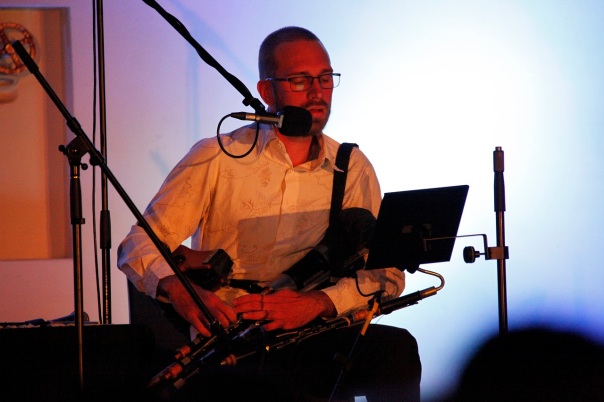
Review by Kishore Minifie Ryan
Liam Flenady’s ‘A Book of Migrations’ is a work of microtonal counterpoint for uillean pipes, a traditional Irish bagpipe-like instrument not customarily heard in Western art music. Drawing on a collaboratively devised set of almost 200 specific microtonal fingerings on the instrument, Matthew Horsley simultaneously reads fragments of the Irish poem Buile Shuibhne. The piece is marked with stark elliptical extracts of the text that switch mid-sentence between English and mediaeval Gaelic. Fragments such as ‘shelter of a single tree’ and ‘sleeping on a hard couch’ are half-buried in the acoustic and electronic textures and it is often it hard to tell which language is being spoken.
The piece begins with a monophonic mid-register drone with slight microtonal variations played by Horsley and accompanied by a very high electronic hiss. This is a significant opening because it foreshadows the tone of the piece and introduces the dichotomy between the traditional acoustic instrument and the electronic accompaniment. Furthermore, the initial pipe drone with electronic hiss introduces questions about the relationship between discernible pitch material and noise. Are these two seemingly contrasting sonic events discrete phenomena? Or are pitch and noise, as Flenady’s composition suggests, capable of combining into something indefinite, something that is neither of those things? At what point does a multiphonic drone become noise? How many partials does it need to have?
The drone falls into a somewhat traditional monophonic melody, each note preceded by one or several grace notes and the last note of each phrase sustained to create an unbroken line. This brief section is as close to traditional Irish music as Flenady’s piece will get. However, the intricate microtonal textures that characterise the piece are countered by the uillean pipe’s unique sound, which prevents a complete redefinition of the instrument.
Flenady’s piece lies in the liminal space between perceptible tone and noise. While the electronics provide several contrasting textures such as a multiphonic drone reminiscent of traffic sounds, distorted pulsing syncopated noise and an undulating bell-like drone, Horsley’s initially tradition playing-style gives way to octopus-eque virtuosity and Ligetian polyphony. Horsley’s low register multiphonic drones and high pitch frenetic microtonal lines are redolent of train horns and cats having sex, respectively.
The piece takes its name from American writer Rebecca Solnit’s book in which she traces her Irish ancestry, strengthening the meaning of the piece. Despite the seemingly impenetrable atonal textures, the instrument’s distinct sound persists and the fact that one note is often sustained against a melodic line, however atonal, underpins the modal connotations. This is what twenty-first century music of the Irish cultural diaspora sounds like.
A Book of Migrations
Matthew Horsley
Bendigo Trades Hall
Bendigo International Festival of Exploratory Music
2 September
Liam Flenady, A Book of Migrations